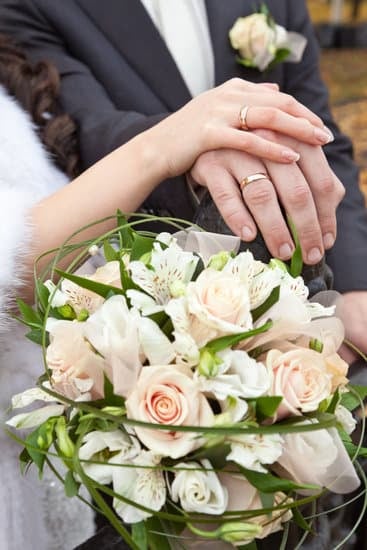Does the wedding ring go above or below? The placement of a wedding ring holds deep significance in various cultures and traditions around the world. This timeless symbol of love and commitment is worn to symbolize the eternal bond between partners, making it essential to understand the proper way to wear it on the finger.
The history of wedding rings dates back centuries, with origins rooted in ancient customs and beliefs. Over time, these symbolic bands have evolved in style and design, reflecting changes in societal norms and personal preferences. Understanding the historical context of wedding rings can shed light on why they are worn in specific ways today.
From cultural traditions to modern trends, the placement of a wedding ring can vary greatly depending on where you are in the world. Different societies have their own beliefs and practices when it comes to wearing these precious symbols of matrimony. Exploring these diverse perspectives can offer insight into the significance of wearing a wedding ring above or below other rings.
History of Wedding Rings
Wedding rings have a long and rich history, dating back thousands of years. The tradition of exchanging rings as a symbol of love and commitment can be traced back to ancient Egypt, where rings made of materials like woven reeds and leather were exchanged between couples. Over time, the use of more durable materials such as metal became popular, symbolizing the enduring nature of the marital bond.
As civilizations evolved, so too did the design and significance of wedding rings. In ancient Rome, for example, wedding rings were often inscribed with romantic messages or imagery symbolizing fidelity. This practice laid the foundation for the use of engraving personal messages on wedding bands that is still common today.
During the Middle Ages in Europe, the wearing of wedding rings became more standardized across different cultures. The circular shape of the ring was believed to symbolize eternity and never-ending love, making it a fitting symbol for marriage. This symbolism has endured through the centuries and is still an important aspect of modern wedding ring traditions.
- Ancient Egyptians exchanged rings made from materials like woven reeds and leather
- Romans inscribed messages or symbols on their wedding rings
- Wedding rings in medieval Europe symbolized eternity and everlasting love
Cultural Traditions
Overview of Cultural Beliefs
In various cultures around the world, the placement of wedding rings holds significant meaning and symbolism. Each culture has its own unique traditions and beliefs when it comes to wearing wedding rings.
For example, in some Eastern European countries like Russia, the wedding ring is traditionally worn on the right hand, while in Western cultures like the United States, it is typically worn on the left hand. Understanding these cultural differences can provide insight into why people choose to wear their wedding rings a certain way.
Eastern vs. Western Traditions
In Eastern cultures such as India and China, it is common for couples to exchange wedding rings during the ceremony and wear them on their right hands. This tradition reflects cultural norms and values specific to those regions.
On the other hand, in Western societies like the UK and US, wearing the wedding ring on the left hand is more common due to historical customs and religious practices. These differences highlight how cultural traditions play a role in determining where the wedding ring should be placed.
Symbolism Behind Placement
The varying cultural beliefs surrounding wedding ring placement often stem from symbolism associated with different fingers on the hand. For instance, in some cultures, it is believed that wearing the wedding ring on a particular finger can enhance love and connection between partners. Understanding these symbolic meanings can help individuals make an informed decision about where they want to wear their wedding ring based on their own cultural background or personal beliefs.
Engagement Ring Placement
Engagement rings and wedding rings hold significant meaning as symbols of love, commitment, and partnership. When it comes to wearing these rings, a common question that arises is: does the wedding ring go above or below the engagement ring? The answer to this question often depends on cultural traditions, personal preferences, and etiquette guidelines.
In many Western cultures, including the United States, the tradition is to wear the engagement ring closer to the heart, followed by the wedding ring on the same finger. This means that the wedding ring is typically worn below the engagement ring. However, in some cultures or personal practices, individuals may choose to wear their wedding ring above their engagement ring.
The decision of whether to wear the wedding ring above or below the engagement ring is ultimately a personal choice. Some people prefer having their wedding band closer to them as a symbol of their union, while others may prioritize wearing their engagement ring first because of its significance as a promise of marriage. Ultimately, there is no right or wrong way to wear these rings; it all comes down to what feels meaningful and comfortable for each individual.
| Country | Common Ring Placement |
|---|---|
| United States | Engagement Ring above Wedding Ring |
| France | Wedding Ring above Engagement Ring |
| India | Varies by Region and Tradition |
Modern Trends
In today’s society, the placement of wedding rings has become a topic of interest and discussion among couples. With changing societal norms and evolving fashion trends, there is a shift in how people choose to wear their wedding rings. One of the most common questions that arise is: does the wedding ring go above or below other rings?
In recent years, a popular trend has emerged where couples opt to wear their wedding ring above their engagement ring. This symbolizes the transition from being engaged to being married, with the wedding band taking precedence over the engagement ring. This trend reflects a modern approach to marriage and showcases the importance of the lifelong commitment that comes with exchanging vows.
Another modern trend in wedding ring placement is stacking multiple bands on one finger. This allows individuals to mix and match different metals, stones, or styles to create a unique look that represents their personal style and love story. Whether it’s wearing two wedding bands on either side of an engagement ring or adding anniversary bands over time, stacking rings have become a popular choice for those looking to make a statement with their jewelry.
As society continues to evolve, so do the customs and traditions surrounding weddings and marriage. The placement of wedding rings can serve as a reflection of an individual’s values, beliefs, and personal preferences. Ultimately, whether the wedding ring goes above or below other rings is a decision left up to each couple to make based on what holds significance for them in their union.
Symbolism
When it comes to wearing wedding rings, the placement on the finger holds significant symbolism. The choice of whether to wear the wedding ring above or below other rings can have various meanings and implications. Understanding the symbolism behind this decision can add depth to the tradition of exchanging rings in a marriage.
Symbolism of Wearing the Wedding Ring Below Other Rings
Wearing the wedding ring below other rings, such as an engagement ring or other decorative bands, is often seen as a way to symbolize the hierarchy of relationships in one’s life. The wedding ring, being the most significant symbol of marital commitment, is placed closest to the heart when worn below other adornments. This gesture signifies that the marriage bond takes precedence over all other relationships and commitments.
Symbolism of Wearing the Wedding Ring Above Other Rings
On the contrary, wearing the wedding ring above other rings can symbolize prioritizing selflessness and unity within a marriage. By placing the wedding ring above other adornments, individuals may choose to symbolize that their commitment and love for their spouse transcends personal desires or external influences. This act can represent putting the needs and happiness of their partner above all else.
Delving into the symbolism behind wearing the wedding ring above or below other rings allows couples to infuse deeper meaning into their relationship through this simple yet profound gesture. Ultimately, whether one chooses to wear their wedding ring above or below other rings should be a personal decision that reflects their values, beliefs, and unique connection with their partner.
Etiquette
Wedding ring placement is a topic that has been surrounded by various traditions and etiquette guidelines. Whether the wedding ring goes above or below other rings on the finger can sometimes depend on cultural practices, personal preferences, or simply following traditional norms. In formal settings, such as weddings or formal events, there are generally accepted guidelines for how to wear the wedding ring in relation to engagement rings or other jewelry.
In most Western cultures, including the United States, the tradition is to wear the wedding band on the fourth finger of the left hand. This tradition dates back centuries and is believed to have originated from the Romans, who believed that this finger had a vein directly connected to the heart.
When it comes to which ring goes first – engagement ring or wedding band – etiquette typically dictates that the wedding band should be worn closest to your heart, meaning it goes below the engagement ring.
However, in more modern times, there has been an increase in personalization and flexibility when it comes to wedding ring placement. Some individuals choose to wear their engagement and wedding rings on separate hands, while others mix and match different metals and styles.
Ultimately, where you place your wedding ring in both formal and informal settings should be based on what feels right for you as a couple. As long as the symbolic meaning behind wearing a wedding ring remains intact, the specific placement above or below other rings becomes a matter of personal preference rather than strict etiquette guidelines.
| Wedding Ring Placement Guidelines | Formal vs Informal Settings |
|---|---|
| Wedding band traditionally worn on fourth finger of left hand | Etiquette dictates wearing wedding band closest to heart |
| In modern times, flexibility allows for personalized choices | Some opt for wearing rings on separate hands or mixing styles |
Personal Preferences
Personal preference plays a significant role in determining where to wear the wedding ring. Some may opt to follow traditional customs and wear the wedding ring below other rings, while others may prefer to have it placed above for personal reasons. Ultimately, the decision should reflect the individual’s values, beliefs, and comfort level.
To better understand the importance of personal preferences in wedding ring placement, consider the following factors:
- Style: Some individuals may choose to wear their wedding ring above other rings as a fashion statement or to showcase the uniqueness of their ring set.
- Sentimental Value: For some, wearing the wedding ring above other rings symbolizes prioritizing their commitment and love for their partner above all else.
- Comfort: Personal comfort should also be taken into account when deciding where to wear the wedding ring. Some may find it more comfortable to wear it below other rings to avoid any potential discomfort or interference with daily activities.
Conclusion
In conclusion, the placement of the wedding ring above or below other rings remains a timeless question that has been pondered for centuries. While there are cultural beliefs and traditional practices that dictate where the wedding ring should be worn, ultimately, it comes down to personal preference. Whether you choose to wear your wedding ring above or below your engagement ring or other rings is entirely up to you and what feels right.
Throughout history, wedding rings have been symbols of love, commitment, and unity between partners. The act of exchanging rings during a wedding ceremony signifies the couple’s everlasting bond and serves as a constant reminder of their vows to each other. The placement of the wedding ring on the finger symbolizes the eternal nature of marriage and the unbroken circle represents endless love and devotion.
As times change and societal norms evolve, so do trends in wedding ring placement. Some may opt for unconventional ways of wearing their rings to showcase their individuality and personal style.
Whether it’s stacking multiple rings together or choosing to wear the wedding ring on a different finger, the most important thing is that it holds significance to you and your partner. In the end, what truly matters is the love and commitment shared between two individuals, regardless of where the wedding ring is placed on the finger.
Frequently Asked Questions
Which Goes First Engagement and Wedding Ring?
Traditionally, the engagement ring is worn first followed by the wedding ring. This is because the engagement ring is seen as a promise and the wedding ring symbolizes the fulfillment of that promise.
Does Wedding Ring Go Over or Under?
The wedding ring should go on after the engagement ring. This is to ensure that the wedding ring sits closer to your heart, as it represents the lifelong commitment made during marriage.
Which Goes on Top Wedding or Engagement Ring?
Typically, the wedding ring goes on top of the engagement ring. This is symbolic of sealing the vows made during marriage, with the wedding band being closest to your heart. It also prevents any potential damage to the engagement ring.

I have been involved in marriages for over 20 years helping couples and singles understand more about them.





